Welcome to our comprehensive care guide for Vesicularia Ferrieri, also known as weeping moss. In this guide, we will provide you with all the essential information you need to ensure the proper growth and maintenance of this beautiful aquatic moss in your aquarium.
From its natural habitat and physical characteristics to lighting and water requirements, substrate needs, and propagation tips, we’ve got you covered. Let’s dive in!
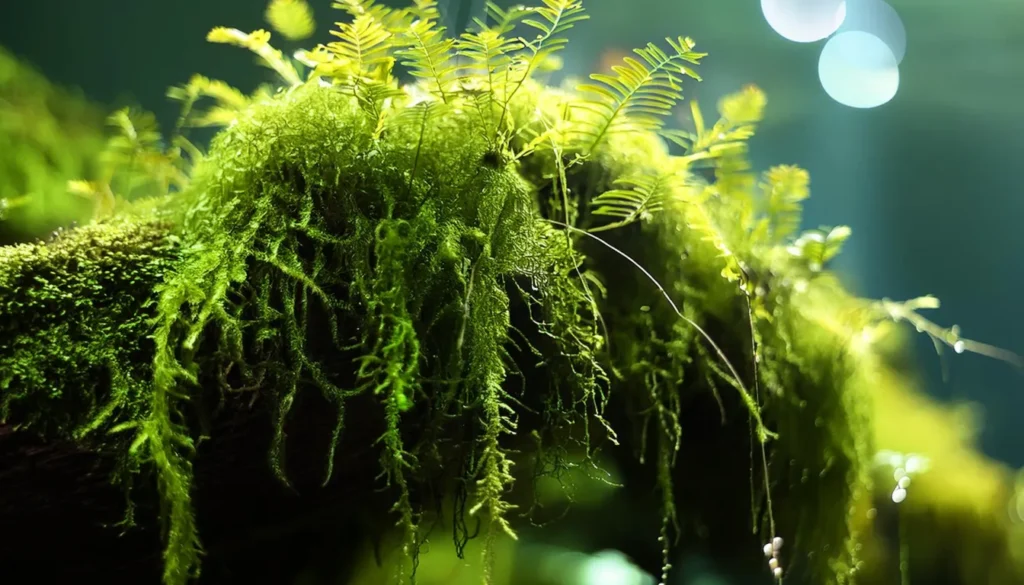
Key Takeaway
- Vesicularia Ferrieri, or weeping moss, is a popular choice for aquarium enthusiasts.
- Proper lighting and water conditions are essential for the healthy growth of weeping moss.
- It can be attached to various surfaces, such as wood or stone.
- Weeping moss provides excellent coverage for small inhabitants and improves water quality.
- Regular maintenance and propagation techniques help maintain the plant’s health and appearance.
Quick Stats
| Attribute | Details |
| Scientific Name | Vesicularia ferriei |
| Common Name | Weeping Moss |
| Origin | Cosmopolitan distribution, native to Southeast Asia |
| Height | 3-5 cm (1.2-2 inches) |
| pH Range | 5.0 – 7.5 |
| CO2 Requirement | Low to Medium |
| Growth Rate | Slow to Moderate |
| Care Level | Easy to Moderate |
| Color Form | Bright green |
| Water Conditions | 18-26°C (64-79°F), adaptable to various water parameters |
| Max Size | Typically remains within the stated height range |
| Lighting | Low to Moderate |
| Supplements | Minimal; benefits from occasional liquid fertilization |
| Placement | Foreground to Midground |
| Propagation | Through division or by attaching small portions to surfaces |
What Is Vesicularia Ferrieri (Weeping Moss)?
Vesicularia Ferrieri, commonly known as weeping moss, is an aquatic moss that grows outward. This unique moss, with its vibrant green color and creeping branches that sag in appearance adds diversity and visual appeal to aquariums and vivariums.
Weeping moss is often used for decoration around hardscapes, as its distinctive hanging look resembles miniature trees. It is a great alternative to common mosses and can easily attach to surfaces like wood or stone using its traditional bryophyte rooting system.
Natural Habitat And Origin
Weeping moss, scientifically known as Vesicularia Ferrieri, is believed to have originated in China. However, its popularity has led to its presence in various parts of Asia and Europe.
This versatile moss typically thrives in freshwater environments, particularly on the shallow bed floors of riverbanks and lakes. It has adapted to different water conditions and can survive in both highly acidic and neutral pH levels.
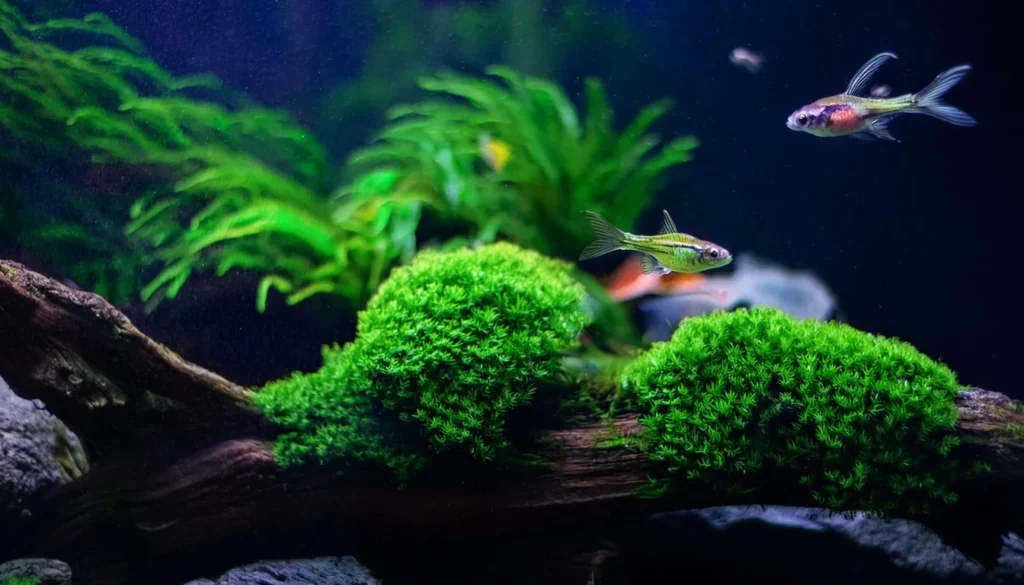
Physical Characteristics
- Weeping moss, scientifically known as Vesicularia Ferrieri, is a visually captivating aquatic plant with unique physical characteristics. This vibrant green moss features a pleurocarpous growth habit, meaning it grows in creeping branches that sag in appearance. The fronds of weeping moss grow outward, giving it a distinct and appealing hanging look. This moss typically reaches a thickness of up to an inch, adding depth and texture to any aquarium or vivarium.
- One of the notable features of weeping moss is its ability to easily attach itself to surfaces like wood or stone. It has a traditional bryophyte rooting system that anchors and latches onto various materials. This natural ability makes weeping moss versatile and convenient to incorporate into different aquarium setups. Whether you want to create a lush moss-covered rock or a tree-like structure, weeping moss is an excellent choice.
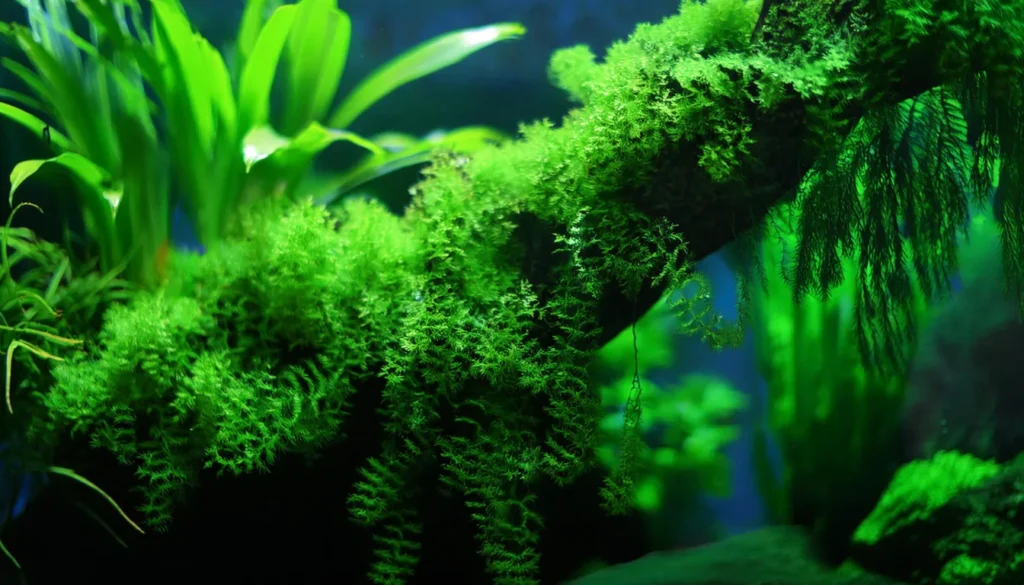
Lighting Demands Of Vesicularia Ferrieri
- Weeping moss, or Vesicularia Ferrieri, requires specific lighting conditions to thrive in an aquarium setting. In its natural habitat, weeping moss receives shade and partial sunlight as it grows in shallow depths of open water. To replicate these conditions indoors, it is recommended to provide a high level of brightness without exposing the moss to direct sunlight.
- Cooler color lights that mimic a cloudy day are ideal for weeping moss. These lights provide the necessary intensity while avoiding excessive heat or direct light that may cause the moss to dry out or burn. Finding the right balance of light is crucial for the health and growth of weeping moss in your aquarium.
Optimal Water Needs Of The Plant
- Weeping moss, also known as Vesicularia Ferrieri, thrives in freshwater environments and has specific water requirements for healthy growth. Proper water conditions are essential to ensure the well-being of this aquatic moss in your aquarium.
- Weeping moss prefers slightly acidic water with a pH range between 5.0 and 6.0. However, it can also tolerate more neutral pH levels. It is important to monitor and maintain the pH level within the recommended range to provide an optimal environment for the moss.
- Regular water changes are necessary to maintain water quality and prevent the build-up of harmful substances in the aquarium. Stagnant water should be avoided as it can negatively affect the health of weeping moss.

Ideal Water Temperature For Growth
- In order to create the optimal conditions for the growth and health of weeping moss, it is important to consider the water temperature in your aquarium. The ideal water temperature range for weeping moss, also known as Vesicularia Ferrieri, is between 60°F and 70°F.
- This temperature range closely mimics the average temperatures in the moss’s native habitat. Maintaining a stable and suitable water temperature within this range will promote healthy growth and ensure the plant’s longevity in your aquarium.
- It is essential to keep in mind that temperature fluctuations can negatively impact the growth and overall well-being of weeping moss. Therefore, it is recommended to use a reliable aquarium heater to maintain a consistent water temperature within the optimal range.
- Regular monitoring of the water temperature and adjusting the heater accordingly will help create a favorable environment for the moss to thrive.

Substrate Requirement
- Weeping moss, also known as Vesicularia Ferrieri, has unique substrate requirements due to its shallow root structure and nutrient absorption capabilities.
- In its natural habitat, this moss can be found growing on fallen branches or nestled between rocks. To replicate this in an aquarium setting, it is important to provide a firm surface for the moss to attach to and grow.
- One common method of attaching weeping moss to aquarium décor is by using aquarium-safe glue or fishing line. This allows the moss to securely latch onto rocks or driftwood, creating a natural and aesthetically pleasing arrangement. Additionally, weeping moss can also attach itself to various substrate textures such as wood, gravel, and sand.
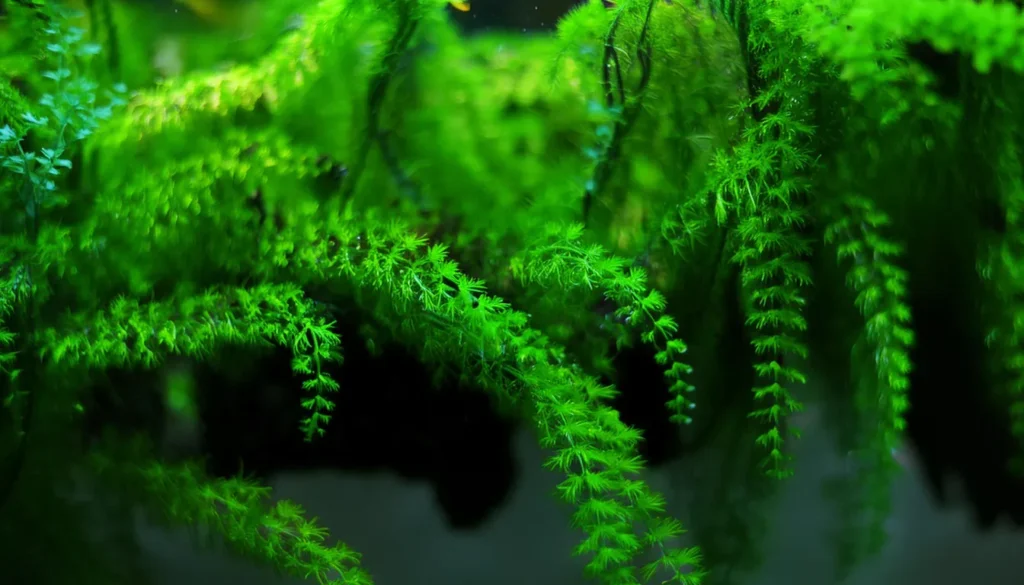
Placement Options In The Tank
- Foreground Placement: Placing weeping moss in the foreground of your aquarium creates an eye-catching focal point. The cascading branches and vibrant green color of the moss add depth and visual interest to the tank.
- Tied to Rocks or Wood Pieces: Attaching weeping moss to rocks or wood pieces provides a natural and aesthetically pleasing look. The moss clings to these surfaces using its traditional bryophyte rooting system, enhancing the overall appearance of your aquascape.
- Coverage for Small Inhabitants: Weeping moss offers excellent coverage and hiding spots for small inhabitants such as fry or shrimp. The dense foliage provides a safe and secure environment, promoting the well-being of these delicate creatures.
RELATED: Echinodorus Horemanii Red For A Vibrant Aquarium Plant
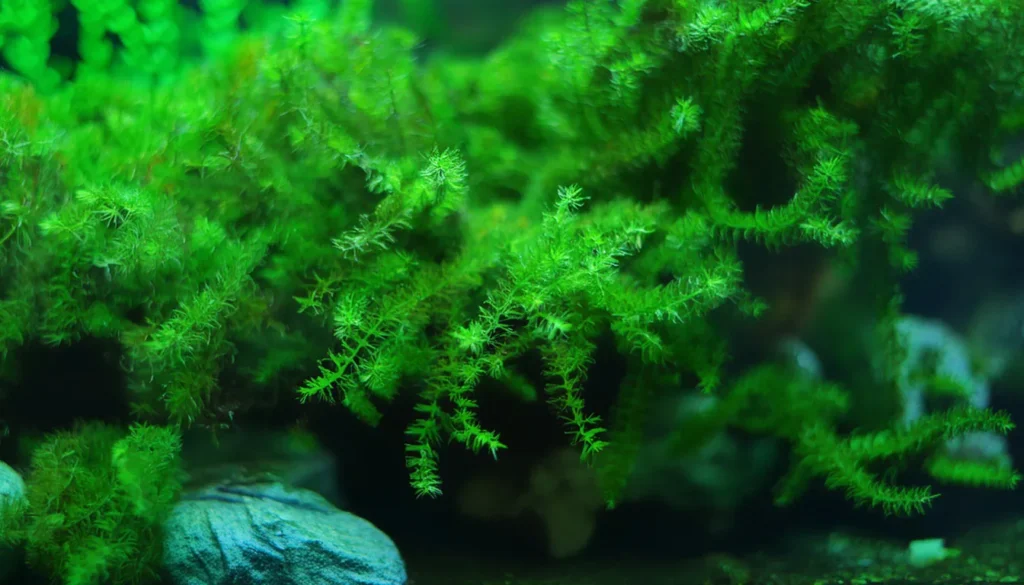
Recommended Tank Size
- Weeping moss, also known as Vesicularia Ferrieri, is a versatile plant that can thrive in a variety of tank sizes. Whether you have a small nano tank or a larger aquarium, weeping moss can adapt to your setup as long as the other environmental conditions are suitable.
- The tank size you choose will depend on several factors, including the overall setup and the other inhabitants you plan to keep. It’s important to consider the space requirements of your desired tank mates, as well as the available lighting and filtration systems.
- When selecting the tank size for weeping moss, keep in mind that this plant is known for its adaptability. It can grow and thrive in various tank sizes, making it suitable for different aquascaping projects and setups.
Suitable Tank Mates
- Small tetras: Species like neon tetras or ember tetras can complement the vibrant green color of the moss and add movement to your aquarium.
- Guppies: These colorful and active fish are known to coexist peacefully with weeping moss and can provide a lively display.
- Rasboras: Small rasbora species like galaxy rasboras or harlequin rasboras can create a stunning contrast with weeping moss and add visual interest.
- Shrimp species: Cherry shrimp or Amano shrimp are excellent companions for weeping moss. They benefit from the moss coverage and contribute to the natural balance of your aquarium ecosystem.
Nutritional Needs Of The Plant
- Weeping moss is a hardy plant that can survive in low-nutrient environments. It primarily obtains nutrients from the water column through its leaves. However, providing additional nutrients can promote healthier and more vibrant growth.
- Liquid fertilizers and nutrient-rich substrates can be beneficial for the overall health of weeping moss. Regular water changes and a balanced nutrient regime help ensure that the plant receives the necessary elements for optimal growth.
Essential Plant Maintenance Tips
- Prune excess growth: Periodically trim any excessive growth to prevent the moss from becoming overcrowded. This will help promote healthy branching and maintain an attractive appearance.
- Remove debris and algae: Regularly clean the moss by gently removing any debris or algae that may accumulate on its surface. This will prevent the moss from becoming discolored and ensure optimal growth.
- Monitor water parameters: Keep a close eye on the water parameters in your aquarium. Weeping moss thrives in specific conditions, including appropriate lighting and water flow. Adjust these factors as needed to create an optimal environment for your moss.
- Perform regular water changes: Regular water changes are crucial for maintaining the overall health of your aquarium and the plants within it. This helps remove any accumulated toxins and ensures a clean and balanced environment for your weeping moss.
- Maintain a clean aquarium environment: Along with regular water changes, it is important to keep your aquarium clean. Regularly remove any organic matter, debris, or uneaten food from the tank to prevent the build-up of harmful substances that can negatively impact the health of your weeping moss.
| Plant Maintenance Tips | Benefits |
| Prune excess growth | Prevents overcrowding |
| Remove debris and algae | Maintains attractive appearance |
| Monitor water parameters | Optimizes growth conditions |
| Perform regular water changes | Ensures a clean and balanced environment |
| Maintain a clean aquarium environment | Prevents the build-up of harmful substances |
Cultivating Vesicularia Ferrieri At Home
- If you want to propagate weeping moss at home, there are several methods you can use. The most common methods include cutting away sections of moss and replanting them in other areas of the tank, securing new clippings with cotton thread or super glue to help them latch onto new surfaces, and allowing the moss to stretch out its creeping branches again.
- It is important to provide the right conditions for propagation, such as low-pH water and moderate lighting. Once the moss is acclimated, regular trimming can be done to maintain the desired look.
Benefits Of Vesicularia Ferrieri
- Weeping moss, also known as Vesicularia Ferrieri, offers a range of advantages that make it a popular choice for aquarium enthusiasts. Its unique appearance adds depth and contrast to aquascapes, creating a natural and visually appealing environment. The vibrant green color and hanging branches of weeping moss provide a beautiful backdrop for your aquatic habitat.
- One of the benefits of weeping moss is its ability to provide excellent coverage for small inhabitants in your aquarium. The dense growth of this moss serves as a hiding place and breeding ground for fish and invertebrates. It creates a safe and secure environment for shy or delicate species, ensuring their well-being and successful reproduction.
- In addition to its aesthetic and functional benefits, weeping moss plays a crucial role in improving water quality. It has the ability to absorb nitrates and other nutrients from the water column, helping to maintain a healthy and balanced ecosystem. By reducing the levels of harmful substances in the water, weeping moss promotes the overall well-being of your aquarium inhabitants.
RELATED: Echinodorus Red Flame To Aesthetically Design Your Aquarium
Conclusion
Caring for Vesicularia Ferrieri, also known as weeping moss, is a rewarding experience that can add beauty and diversity to your aquarium.
By providing optimal lighting, water conditions, and substrate, you can ensure the proper growth and health of this versatile plant. Regular maintenance, such as pruning and removing debris, is essential for its long-term vitality.
Whether you’re a beginner or an experienced hobbyist, weeping moss is a great choice for enhancing your aquatic environment. Its vibrant green color and unique hanging branches create a captivating visual appeal.
Moreover, weeping moss offers functional benefits such as hiding places for small fish and helping to maintain water quality by absorbing excess nutrients.
With proper care and attention, weeping moss can thrive in various aquarium setups, providing years of enjoyment and natural beauty.
So, go ahead and incorporate this beautiful moss into your underwater world and witness the stunning transformation it brings to your aquatic ecosystem.
Frequently Asked Questions
What Are The Suitable Tank Mates For Weeping Moss?
Weeping moss can coexist with a wide variety of fish and invertebrates. It provides excellent coverage and hiding spots for small fish, fry, and shrimp. Some suitable tank mates for weeping moss include small tetras, guppies, rasboras, and shrimp species like cherry shrimp or Amano shrimp.
It’s important to research the intended tank mates’ specific compatibility and behavioral traits to ensure a harmonious aquatic ecosystem.
What Are The Nutritional Needs Of Vesicularia Ferrieri?
Weeping moss is a hardy plant that can survive in low-nutrient environments. It primarily obtains nutrients from the water column through its leaves.
However, providing additional nutrients can promote healthier and more vibrant growth. Liquid fertilizers and nutrient-rich substrates can be beneficial for the overall health of weeping moss.
How Do I Maintain Weeping Moss?
To maintain the health and appearance of weeping moss, regular maintenance is required. This includes pruning any excess growth and removing any debris or algae that may accumulate on the plant.
Trimming the moss helps promote healthy branching and prevents overcrowding. It’s also important to monitor water parameters and ensure that the lighting and water flow are appropriate for the plant’s needs.
Performing regular water changes and maintaining a clean aquarium environment will contribute to the overall well-being of weeping moss.
What Are The Methods Of Propagating Vesicularia Ferrieri?
If you want to propagate weeping moss at home, there are several methods you can use.
The most common methods include cutting away sections of moss and replanting them in other areas of the tank, securing new clippings with cotton thread or super glue to help them latch onto new surfaces, and allowing the moss to stretch out its creeping branches again.
It’s important to provide the right conditions for propagation, such as low-pH water and moderate lighting.
What Are The Benefits Of Vesicularia Ferrieri In An Aquarium?
Weeping moss offers numerous benefits to aquarium enthusiasts. Its unique appearance adds depth and contrast to aquascapes, creating a natural and visually appealing environment.
The moss provides excellent coverage for small inhabitants, serving as a hiding place and breeding ground.
It also helps improve water quality by absorbing nitrates and other nutrients from the water column, helping to maintain a healthy and balanced ecosystem.
Additionally, weeping moss is relatively easy to care for, making it a popular choice for both beginner and experienced aquarists.
- Unveiling The Wonders Of Riccia Fluitans In Aquascapes - August 7, 2024
- Vallisneria Gigantea Var. Guide To Care And Cultivation At Home - July 31, 2024
- Vesicularia Dubyana Care & Growth Guide Tips For Beginner Gardeners - July 30, 2024
